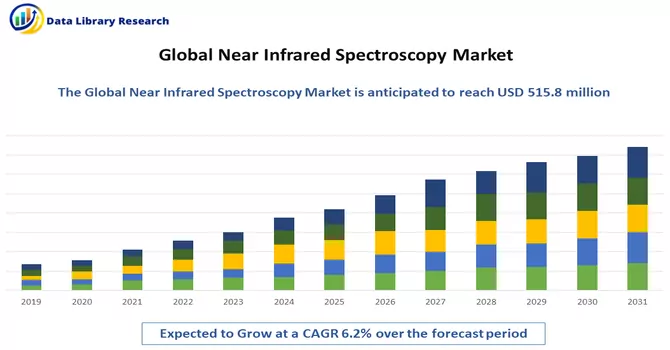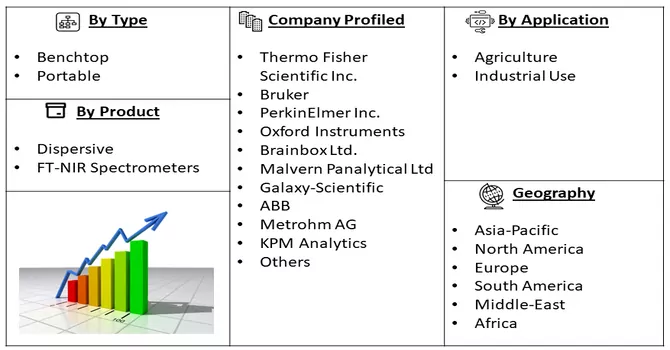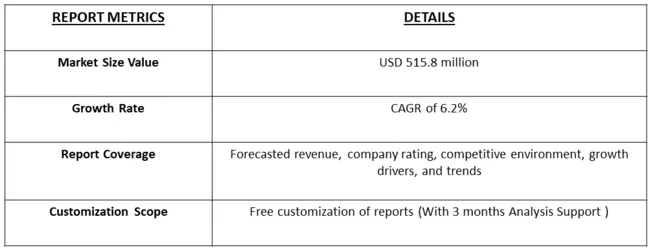The global near-infrared spectroscopy market size was valued at USD 515.8 million in 2023 and is expected to expand at a compound annual growth rate (CAGR) of 6.2% from 2024 to 2031.

Get Complete Analysis Of The Report - Download Free Sample PDF
Near-infrared spectroscopy (NIRS) is a technique used to analyze the composition of materials based on the absorption of near-infrared light. Near-infrared light has wavelengths between 780 and 2500 nanometers, which is beyond the visible spectrum but shorter than mid-infrared radiation. In NIRS, a sample is exposed to near-infrared light, and the amount of light absorbed and reflected is measured. Different molecules absorb light at different wavelengths, so by analyzing the absorption pattern, scientists can determine the chemical composition of the sample. NIRS is commonly used in various industries, including agriculture, pharmaceuticals, food and beverage, and environmental monitoring, due to its non-destructive nature and ability to provide rapid results.
Near-infrared (NIR) spectroscopy is a powerful analytical technique that is widely used for quantitative analysis. It utilizes the near-infrared region of the electromagnetic spectrum, which lies between the visible and mid-infrared regions. NIR spectroscopy is particularly valuable because it can provide a wealth of information about the chemical composition of a sample without the need for extensive sample preparation. One of the key advantages of NIR spectroscopy is its speed and efficiency compared to traditional methods such as wet chemical analysis and liquid chromatography. These methods can be time-consuming and labor-intensive, requiring multiple steps and reagents. In contrast, NIR spectroscopy can provide rapid results, making it an attractive option for industries where timely analysis is critical. NIR spectroscopy is also known for its versatility. It can be used to analyze a wide range of materials, including solids, liquids, and gases, making it applicable to a variety of industries. Additionally, NIR spectroscopy does not require the destruction of the sample, allowing for non-destructive analysis and the possibility of reusing the sample for further testing. The growth of NIR spectroscopy is further supported by its cost-effectiveness. Implementing NIR spectroscopy can lead to cost savings for companies, as it reduces the need for expensive reagents and equipment. Furthermore, NIR spectroscopy is a relatively simple technique to operate, requiring minimal training for users. Thus, NIR spectroscopy is a valuable analytical tool that offers numerous advantages, including speed, versatility, and cost-effectiveness. Its ability to provide rapid and accurate analysis makes it an indispensable tool in industries such as pharmaceuticals, nutraceuticals, food and beverage, and agriculture, where precise and timely analysis is essential.
Market Segmentation: The Near-infrared Spectroscopy Market is Segmented by Type (Benchtop, and Portable), Product (Dispersive, and FT-NIR Spectrometers), Application (Agriculture, Industrial Use) and Geography (North America, Europe, Asia Pacific, Middle East and Africa, and South America). The market provides the value (in USD million) for the above-mentioned segments.

For Detailed Market Segmentation - Download Free Sample PDF
The Near-infrared (NIR) spectroscopy market is experiencing significant growth and is expected to continue expanding in the coming years. Key drivers of this growth include the increasing adoption of NIR spectroscopy across various industries such as pharmaceuticals, food and agriculture, and chemicals, driven by its ability to provide rapid and non-destructive analysis. Technological advancements, including the development of portable and handheld NIR spectroscopy devices, are also contributing to market growth by making the technology more accessible and easier to use in field applications. Additionally, the growing demand for quality control and process monitoring solutions is fueling the adoption of NIR spectroscopy in manufacturing processes, further driving market growth.
Market Drivers:
Increased Adoption Across Industries
NIR spectroscopy is witnessing rising adoption in diverse sectors like pharmaceuticals, food, agriculture, and chemicals. This trend is fueled by its capacity for quick, non-invasive, and precise analysis, proving crucial for quality assurance, process surveillance, and research needs. Its versatility and effectiveness are driving its integration into various industries, promising enhanced productivity and quality standards.
Technological Advancements
The evolution of NIR spectroscopy technology, notably the emergence of portable and handheld devices, is propelling market expansion. These advancements are democratizing NIR spectroscopy, making it more user-friendly and accessible. Portable devices enable on-site analysis, reducing the need for samples to be transported to laboratories, thus saving time and resources. Moreover, the user-friendly nature of these devices is attracting a wider range of users, including those without extensive scientific backgrounds. This increased accessibility is driving the adoption of NIR spectroscopy in field applications, where real-time analysis is critical. Additionally, these technological strides are opening doors to new markets, particularly in emerging economies where there is a growing demand for efficient and cost-effective analytical solutions. As a result, NIR spectroscopy is increasingly becoming a cornerstone technology in industries such as agriculture, environmental monitoring, and food safety.
Market Restraints:
Market restraints for NIR spectroscopy include high initial investment costs for equipment and training, which can deter smaller companies from adopting the technology. Additionally, while NIR spectroscopy is versatile, it may not be suitable for all types of analyses, requiring complementary techniques in some cases. There can also be challenges related to standardization and calibration of instruments across different applications and industries, leading to potential inconsistencies in results. Furthermore, regulatory constraints and the need for validation in certain industries, such as pharmaceuticals, can hinder the widespread adoption of NIR spectroscopy. These factors, combined with competition from alternative technologies, pose challenges to the growth of the NIR spectroscopy market.
The COVID-19 pandemic has had a mixed impact on the NIR spectroscopy market. While there has been a temporary slowdown in the adoption of NIR spectroscopy due to disruptions in supply chains and project delays, the pandemic has also highlighted the importance of rapid and non-destructive analytical techniques. This has led to an increased interest in NIR spectroscopy for applications such as medical diagnostics, pharmaceuticals, and food safety. Additionally, the shift towards remote working has created a demand for portable and handheld NIR spectroscopy devices, further driving market growth. Overall, while the short-term impact of the pandemic has been challenging, the long-term outlook for the NIR spectroscopy market remains positive as industries recognize the value of this technology in ensuring product quality and safety.
Segmental Analysis:
Portable Segment is Expected to Witness Significant Growth Over the Forecast Period
Portable infrared spectroscopy offers several advantages, including its ability to provide rapid and on-site analysis, eliminating the need for samples to be transported to a laboratory. This not only saves time but also reduces costs associated with sample handling and transportation. Portable devices are typically user-friendly and require minimal training, making them accessible to a wider range of users. Additionally, these devices are compact and lightweight, making them ideal for field applications where space is limited. The non-destructive nature of infrared spectroscopy allows for the analysis of samples without altering or damaging them, preserving sample integrity. Overall, portable infrared spectroscopy offers convenience, efficiency, and versatility, making it a valuable tool for a variety of industries and applications.
Furthermore, the launch of new products are expected to drive the growth of the studied segment. For instance, in February 2022, Bruker Optics unveiled the MOBILE-IR II, a portable, battery-powered Fourier Transform Infrared (FT-IR) spectrometer that offers the same high spectral performance as a laboratory benchtop system. This innovative mobile spectrometer opens up new possibilities for users worldwide to conduct routine and advanced FT-IR applications in the field. The launch of the MOBILE-IR II is expected to drive significant growth in the portable spectroscopy market. This is because the device addresses the increasing demand for portable spectroscopy solutions that can deliver accurate and reliable results outside of traditional laboratory settings. With its portability and high performance, the MOBILE-IR II is poised to expand the application of spectroscopy across industries such as pharmaceuticals, environmental monitoring, and materials science, driving further innovation and adoption of portable spectroscopy technologies.
FT-NIR Spectrometer Segment is Expected to Witness Significant Growth Over the Forecast Period
The advantages of a Fourier Transform Near-Infrared (FT-NIR) spectrometer include its ability to quickly and accurately analyze samples, providing valuable insights into their chemical composition. FT-NIR spectrometers are non-destructive, allowing for the analysis of samples without altering or damaging them, preserving sample integrity. These spectrometers are also versatile, able to analyze a wide range of materials, including solids, liquids, and gases. Additionally, FT-NIR spectrometers are relatively easy to use and require minimal sample preparation, saving time and reducing costs. Their high sensitivity and precision make them valuable tools for quality control, process monitoring, and research in industries such as pharmaceuticals, food and agriculture, and chemicals.
North America Region is Expected to Witness Significant Growth Over the Forecast Period
Near-infrared spectroscopy (NIRS) finds extensive industrial application due to its non-destructive nature and ability to provide rapid and accurate analysis. In the pharmaceutical industry, NIRS is used for quality control of raw materials, formulation development, and drug manufacturing processes. In the food and agriculture sector, it is employed for assessing the quality of food products, determining nutritional content, and monitoring food production processes. Additionally, NIRS is used in the chemical industry for analyzing chemical compositions, monitoring chemical reactions, and ensuring product quality. Its ability to analyze various materials, including solids, liquids, and gases, makes NIRS versatile across industries, including polymers, textiles, and environmental monitoring, showcasing its value in optimizing processes, ensuring quality, and driving efficiency.

Get Complete Analysis Of The Report - Download Free Sample PDF
The analyzed market exhibits a high degree of fragmentation, primarily attributable to the presence of numerous players operating on both a global and regional scale. The competitive landscape is characterized by a diverse array of companies, each contributing to the overall market dynamics. This fragmentation arises from the existence of specialized solution providers, established industry players, and emerging entrants, all vying for market share. The diversity in market participants is underscored by the adoption of various strategies aimed at expanding the company presence. On a global scale, companies within the studied market are strategically positioning themselves through aggressive expansion initiatives. This often involves entering new geographical regions, targeting untapped markets, and establishing a robust global footprint. The pursuit of global expansion is driven by the recognition of diverse market opportunities and the desire to capitalize on emerging trends and demands across different regions. Simultaneously, at the regional level, companies are tailoring their approaches to align with local market dynamics. Regional players are leveraging their understanding of specific market nuances, regulatory environments, and consumer preferences to gain a competitive edge. This regional focus allows companies to cater to the unique needs of local clientele, fostering stronger market penetration. To navigate the complexities of the fragmented market, companies are implementing a range of strategies. These strategies include investments in research and development to stay at the forefront of technological advancements, mergers and acquisitions to consolidate market share, strategic partnerships for synergies, and innovation to differentiate products and services. The adoption of such multifaceted strategies reflects the competitive nature of the market, with participants continually seeking avenues for growth and sustainability. In essence, the high fragmentation in the studied market not only signifies the diversity of players but also underscores the dynamism and competitiveness that drive ongoing strategic maneuvers. As companies explore various avenues for expansion, the market continues to evolve, presenting both challenges and opportunities for industry stakeholders.
Some of the key market players are:
Recent Development:
1) In 2022, ABB has announced its intention to deploy the MB3600 Fourier transform NIR spectrometer for analyzing and detecting raw materials in cement production. This endeavor, backed by the National Natural Science Foundation of China, marks a strategic move for ABB to enter multiple markets using a single product, thereby reducing costs. The initiative is expected to spur the growth of near-infrared (NIR) spectroscopy by demonstrating its effectiveness and reliability in a crucial industry like cement manufacturing. By showcasing the value of NIR spectroscopy in this context, ABB aims to attract new customers and enhance its presence in the spectroscopy market. Moreover, the application of NIR spectroscopy in cement production underscores its adaptability and potential for use in other sectors, further fueling its expansion and adoption.
2) In 2020, trinamiX GmbH, based in Ludwigshafen, Germany and a subsidiary of BASF SE, has introduced a new mobile solution for near-infrared (NIR) spectroscopy. This technology, known for its effectiveness in analysis, is now made more affordable and accessible by trinamiX, extending its use beyond traditional factory and laboratory settings. trinamiX provides a comprehensive solution in a single handheld device, offering durable hardware, accurate data and material analysis, and extensive molecular and chemical expertise.
Q1. What was the Near Infrared Spectroscopy Market size in 2023?
As per Data Library Research the global near-infrared spectroscopy market size was valued at USD 515.8 million in 2023.
Q2. At what CAGR is the Near Infrared Spectroscopy market projected to grow within the forecast period?
Near Infrared Spectroscopy Market is expected to expand at a compound annual growth rate (CAGR) of 6.2% over the forecast period.
Q3. What are the Growth Drivers of the Near Infrared Spectroscopy Market?
Increased Adoption Across Industries and Technological Advancements are the Growth Drivers of the Near Infrared Spectroscopy Market.
Q4. Who are the key players in Near Infrared Spectroscopy Market?
Some key players operating in the market include
Data Library Research are conducted by industry experts who offer insight on industry structure, market segmentations technology assessment and competitive landscape (CL), and penetration, as well as on emerging trends. Their analysis is based on primary interviews (~ 80%) and secondary research (~ 20%) as well as years of professional expertise in their respective industries. Adding to this, by analysing historical trends and current market positions, our analysts predict where the market will be headed for the next five years. Furthermore, the varying trends of segment & categories geographically presented are also studied and the estimated based on the primary & secondary research.
In this particular report from the supply side Data Library Research has conducted primary surveys (interviews) with the key level executives (VP, CEO’s, Marketing Director, Business Development Manager and SOFT) of the companies that active & prominent as well as the midsized organization
FIGURE 1: DLR RESEARH PROCESS

Extensive primary research was conducted to gain a deeper insight of the market and industry performance. The analysis is based on both primary and secondary research as well as years of professional expertise in the respective industries.
In addition to analysing current and historical trends, our analysts predict where the market is headed over the next five years.
It varies by segment for these categories geographically presented in the list of market tables. Speaking about this particular report we have conducted primary surveys (interviews) with the key level executives (VP, CEO’s, Marketing Director, Business Development Manager and many more) of the major players active in the market.
Secondary ResearchSecondary research was mainly used to collect and identify information useful for the extensive, technical, market-oriented, and Friend’s study of the Global Extra Neutral Alcohol. It was also used to obtain key information about major players, market classification and segmentation according to the industry trends, geographical markets, and developments related to the market and technology perspectives. For this study, analysts have gathered information from various credible sources, such as annual reports, sec filings, journals, white papers, SOFT presentations, and company web sites.
Market Size EstimationBoth, top-down and bottom-up approaches were used to estimate and validate the size of the Global market and to estimate the size of various other dependent submarkets in the overall Extra Neutral Alcohol. The key players in the market were identified through secondary research and their market contributions in the respective geographies were determined through primary and secondary research.
Forecast Model
